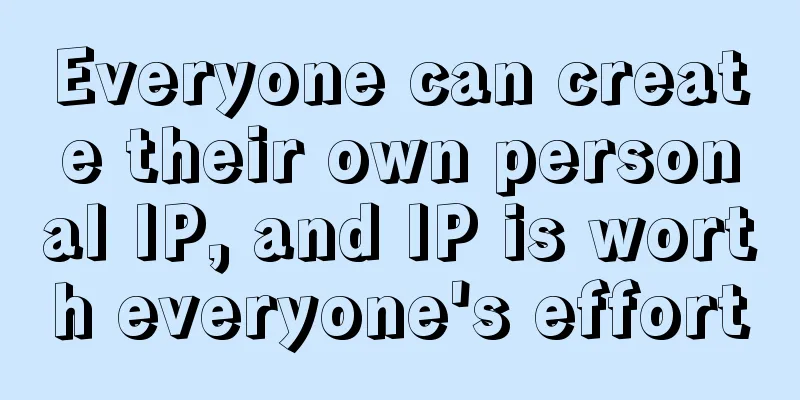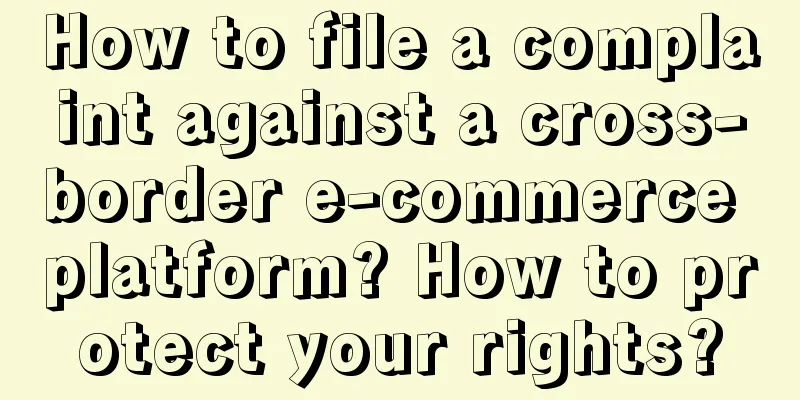Everyone can create their own personal IP, and IP is worth everyone's effort

This article is long but very concise, so it is recommended that you save it first. Recently I have been thinking about what IP is and how to build my own personal IP. Now the Internet has greatly magnified personal capabilities, so personal IP will become more and more important in the future. This is the trend. In fact, I think IP can be simply described as: focus + professionalism + verticality + persistence + continuous output + altruism + value + trust + accumulation + patience. When creating an IP, users should be attracted by the appearance, fall in love with the talent, and be loyal to the character. The trust and preference generated by resonance of values, recognition of character, and affirmation of value are the ultimate destination of personal IP. What we are doing with IP now is actually knowledge IP. Knowledge IP is a business model based on individuals. Its essence is to rely on the output of knowledge-based content to continuously obtain traffic, and it also needs to create its own knowledge-based products/services to achieve stable and sustainable monetization. Knowledge IP is to output professional knowledge and solve problems for users. In fact, IP can be created in any industry. For service-oriented industries such as housekeeping, professional knowledge can be output, such as how to clean the air conditioner and how to clean the kitchen more cleanly. For product-oriented industries such as clothing, IP can teach others how to match clothes. Knowledge IP itself needs to be continuously output and provide value to users. This can also force oneself to continue to grow, learn and input. Everyone can also create their own knowledge IP. The knowledge reserve threshold for IP is actually not that high. As long as you have more than 3 years of experience in a professional field and some knowledge summary and content output capabilities, it is enough. You can even start with just a little knowledge. Many friends say that they don’t have many fans , can they create IP, can they make money? In fact, laymen look at the number of fans, while experts only look at conversion rate and accuracy. The future is definitely not about the number of fans, but about the quality, monetization ability and accuracy of fans. Some big Vs have millions of fans, but the quality of their fans is not high and not accurate. Many of them are general fans, which makes it difficult to monetize or the monetization ability is not high. I think that in the next few years, don’t even think about creating a big IP with millions of fans. Such opportunities are rare and difficult to achieve. But you can create a knowledge IP with 10,000 to 100,000 precise fans, and you can steadily monetize 10,000 to 100,000 yuan per month. Before you create a personal IP, you need to think clearly about what your monetization products are, who they are for and what problems they solve, and then you can create content specifically for this group of people and output it to attract high-quality, accurate traffic, so that you can monetize better. The starting point for thinking about monetization is always your product, user needs and pricing. Being a personal IP is actually about helping users solve problems and making some money at the same time. In fact, no matter what you do, no matter how poor your ability is, you can make an IP. As long as there is a potential difference, you can make an IP, and if you want to make an IP , you must have a potential difference: the flow of value is from 90 points to 80 points, from 80 points to 70 points, layer by layer, and the flow of value at each layer will produce a potential difference . If you are not very capable, but have 60 points, you can help those with less than 50 points. Although you can make an IP as long as there is a potential difference, you must at least make yourself pass the score, that is, above 60 points, so that you can help those with less than 60 points, especially the newbies. Therefore, when we create IP, we must find our own potential difference. When creating IP, you can learn and help others while doing it. You don’t have to wait until you have very strong abilities to do it. You can create IP, learn, and help users solve problems at the same time. I think the important carrier of IP is the private domain traffic pool. The most important thing about the private domain traffic pool is WeChat user operation and circle of friends operation. Important components of IP:
With positioning as the center, we will create a closed loop around altruism, traffic generation, content, user operations, and monetization. We said above that this is an era that values fan quality, monetization capabilities, and accuracy, so we must do a good job in precise positioning, precise users, precise traffic, precise conversions, precise content, and precise monetization. 1. PositioningThe first step to building a personal IP is positioning. The essence of positioning is knowing how to give up. The more you can position yourself in a highly vertical field, the faster you can build an IP. Vertical, vertical, and vertical again, this is the key for novices to get started. To put it simply, positioning means that when you see Haidilao, you know it is a hotpot restaurant, and if you want to eat hotpot, you will think of Haidilao. The purpose of our positioning is to stand out among the massive amount of content and the massive amount of homogeneous IPs. Now there is too much homogeneous content and too many homogeneous IPs. Among the massive amount of information, how do you make readers choose you and how do you attract users' attention and arouse their interest has become a difficult problem before us. Therefore, we must do a good job in user positioning, clarify user portraits, determine the niche areas, and then focus and persist in the long term . So how should we do positioning specifically? I think it should start from three aspects: one is personal positioning, two is user positioning, and three is account positioning. 1. Personal positioning
To understand these problems, we need to find the intersection of these problems. Because we are interested, we can persist better. Because we are good at it, we will be more confident. Because what we provide is valuable, people will need it. Only by knowing who needs it can we know our user groups. 2. User PositioningTo target users, you need to understand who your target users are? Which groups are they? Which online platforms will they appear on? What are their characteristics? What is the user portrait like? 3. Account positioning (equivalent to personality and label)
Answer the above questions, and then position the account from the above aspects. After choosing the right track and clarifying your positioning, find your own differences in the niche areas. The book "Positioning" states: In order to occupy a category in the minds of consumers with limited capacity, the best way for a brand to differentiate is to be the first, to be the category leader or pioneer, and secondly to differentiate the category, to be the only one in the sub-category (that is, the first in the sub-category) or to become the opponent of the first in the category. Focusing on niche areas + user insights + analyzing industry pain points is the secret to differentiated positioning. When looking for differentiation in a clear niche, ask yourself these four questions.
We need to find a segmented demand to work on. Segmented demand is consumer demand, which is what users are willing to spend money on. If you want to think about scenarios where users are willing to spend money, under what circumstances are they willing to spend money? Why are you willing to spend money? What do you want to gain (what do you not want to lose)? How can I help you? What can I help you avoid? When we talk about positioning, we are actually talking about three issues:
2. AltruismBe altruistic in your thinking, don't just think about yourself, don't be reluctant to share your experiences, and don't be afraid of being learned by others. To provide value to users and others, you must actively connect with others, or if you have the ability and value, others will actively connect with you. You must also be good at sharing, sharing practical information, sharing life, and sharing experiences. 3. DrainageThree elements for traffic generation: channel + content + hook (bait). The hook is the WeChat account or official account, which is where you want to direct traffic. Use the right content through the right channels to demonstrate your value, gain trust, and then use the right bait and hooks to attract traffic. The content must be valuable to the target audience, and the bait must be attractive to the target audience There are three types of drainage channels: precise drainage, cooperative drainage, and public domain drainage. 1. Accurate traffic diversionGo straight to the target users. Take the initiative to penetrate into the target users’ gathering places and conduct precise traffic diversion. 1) Accurate traffic channel 1: Q&A search Find relevant questions on Zhihu and use Zhihu associative search. The average number of likes for the top three answers does not exceed 200, and the daily new views exceed 200, which are considered good questions. In addition to Zhihu, there are also answers on Toutiao. There are other answer platforms, search platforms, and answer platforms that are worth paying attention to. Study which platforms there are and how to do a good job of searching related questions. Go to 5118 to find keywords, associated words, and long-tail words. In fact, Zhihu is a very good channel for attracting traffic, and it is worth doing well. As for how to do Zhihu well, I have written relevant articles, you can go and have a look. 2) Precision traffic channel 2: vertical forum Comprehensive vertical forums: Hupu, Douban Group, Tieba. Many industries have their own vertical communication forums, so think clearly about which industries and professions your users are from. 3) Precision traffic channel three: vertical community Most of the communities are paid groups/knowledge planets/little red circles of KOLs. Think clearly about which paying groups your target users will appear in. Continue to output value in relevant communities and forums, and start to attract traffic and place hooks when you have a certain influence and a certain sense of trust. How do you know where the user is? The target users' needs related to your field and other needs of the target users. The traffic-generating content should have the same tone as the community, forum, and website. People have many needs. Your IP can generally only meet one need of users. Think about what other needs your target users have? Shopping? Learning? Entertainment? Industry communication? Actively provide value, actively benefit others, actively show yourself, and passively attract target users to add you actively. Cooperation, making friends, altruism, sharing, providing value, self-worth, and reliability are very important elements in creating IP. Helping others and achieving yourself is very important in IP development. 2. Cooperation and traffic diversion1) Collaborative traffic diversion 1: Mutual traffic diversion If the user groups overlap but the businesses and interests do not conflict, they can cooperate with each other and increase their followers together. You must first determine your own user attributes, and then look for IPs that are similar to your user attributes. Two IPs of similar size can recommend and divert traffic to each other. How can two IPs of different sizes promote each other?
2) Cooperation and traffic generation 2: Guest sharing Provide sharing lectures for the other party's users, that is, go to other groups to share as a guest. The users who share the traffic are locked in and the subsequent transactions are paid commissions to the other party, giving the other party benefits. 3) Cooperation and traffic generation 3: Delivery IP user attributes are similar. Post it on the other party’s circle of friends/public account/other social platforms. 3. Public domain drainage: continuous drainageThe same content is replicated and output on multiple platforms, continuously drawing traffic from the public domain. Common public domain platforms include Toutiao, Baidu Baike, Zhihu, Xiaohongshu, Weibo, etc. Traffic diversion can be summarized in one sentence: divert traffic to where your users will go . Use the right content in the right channel to reflect your value, gain trust, and then use the right bait and hook to divert traffic. There are two directions where users will go:
Key points of channel diversion:
IV. ContentFour key contents, none of which can be missing:
The standard path for a new user to follow a public account or add WeChat:
Finding the problem of IP positioning users and then helping users solve these problems is professionalism. Building a personal IP is about solving the trust problem. It is very difficult for you to trust a stranger, and everyone is on guard. But interpersonal communication emphasizes "first time is strange, second time is familiar". With continuous content exposure, users will become more and more familiar with you, and trust is subtly established in this familiar process. To build a personal IP, you must be dedicated and focused, because a personal IP is a symbol that represents a group of people and a type of content. To build a personal IP, you must output original high-quality content. Even if you refer to this content from other places, you must implant your own opinions. This is the essential difference between a personal IP and an industry account. The former has its own opinions, while the latter is just an information intermediary. Why do we need to output a lot of content every day? Because these contents are customized for target users, we rely on content to identify the core users we want, and then rely on content to attract the attention of these users. If you don’t have content output, or the content you output is too general, you can’t get the users you want. To create content, you need continuous output and distribution channels. Continuous output means updating content steadily and continuously. The distribution channel is to distribute content on various platforms, but there must be a stable update and monetization channel. I think the most stable and long-term updated channel is WeChat. Other common distribution channels include Toutiao, Baidu Baike, Zhihu, Xiaohongshu, Weibo, etc. 5. User OperationUser operation mainly refers to the refined operation of users and friend circle operations on WeChat. The core of user operation is to increase revenue (acquire users), reduce costs (reduce churn), complete transactions, and spread fission. In fact, every user has a life cycle, from the introduction period, cultivation period, maturity period, dormancy period to the churn period. We should have different operational focuses for users in different periods and create commercial value as much as possible in the user's life cycle. We all know that any user will go through such a life cycle, and what we need to do is to extend the user's life cycle as much as possible. 1. Refined operationsUser operations should be targeted at different groups of people, that is, operations should be refined. The so-called refined operation, the first is detail, the second is classification. You need to edit labels and classify users on WeChat. Note the user's personal introduction, needs, pain points, concerns, interests, and concerns. The more detailed the user's situation notes are, the better. Every time you chat with a user, some useful information revealed by the user should also be noted in a timely manner. 2. User trainingThe ultimate goal of user cultivation is to improve retention, enhance user intention, convert payment, and prevent churn. Therefore, we need to interact and contact with users more, provide more value to users, and help users solve problems more. ① Provide value, output value, and adhere to altruism By sharing valuable content in the circle of friends, by helping users solve problems, and by continuously providing help within your ability, you can persist in altruism. Sometimes you have to help users for free, but this help should be easy for you to do and not difficult, because providing difficult help requires time and energy. If you do it for free, it will greatly distract your time and energy, and sometimes you won't even get a thank you from the user. That means you are doing charity. ② Build and strengthen relationships Through interaction with users, likes, comments, private chats, etc. Interact more with users, care about users, respect users, provide value to users, do less marketing, and make friends with users. ③ Build trust and strengthen trust So how do you build trust? 1) Trust comes from authenticity. Are your WeChat name, profile picture, region, signature, etc. authentic and trustworthy? 2) Trust comes from professionalism. Is the content you post on your Moments professional, informative, and valuable? If it is disorganized, people will have no way of knowing what you do. 3) Trust comes from doing one thing consistently. 4) Trust comes from sincere interaction and communication with friends. Don't be boastful or flashy. Your friends will definitely feel your every effort. You must let users know you, get to know you, get familiar with you, and finally trust you. Trust is built up subtly in this familiarity process. 5) Trust comes from the endorsement of more powerful people. It will definitely work if a big V endorses you. 6) Trust comes from a person’s strong self-confidence. The above aspects can be further refined and summarized in three sentences:
3. User transactionYou need to establish and strengthen connections with users, build and strengthen relationships with users, and do a good job of accumulating value and trust. That is, you need to interact more with users, provide more value to users, help users solve problems more, and continuously improve user intention. If they need something, they will naturally come to you, but the prerequisite is that the features of your product can meet the needs and pain points of users. What you can provide should have an intersection with what users want, and this intersection is where you should work hard. In order for people to actively pay, users must meet these four conditions:
This requires using personal IP and content to tell users what I do and how I can help them. Then, through refined user operations and content screening of users with needs, and then through content marketing to influence user decisions, users will finally buy from me because they trust me. The user’s transaction path: find you, connect with you, identify you, remember you, get familiar with you, trust you and finally buy from you. 4. User spread (fission)One is word-of-mouth communication. If users think it is good, they will promote it for you. The second is sharing in the circle of friends. Why do users share? Mainly because it satisfies themselves and benefits others. That is, it is beneficial to themselves and others at the same time. For example, by sharing, the user can get something and his friends can also get something. If you want users to spread the word, you must first answer the following two questions.
I think that personal IP still needs to use private traffic pool as a channel for stable output and monetization, and WeChat is the best private traffic pool. Private traffic pool = funnel model + traffic pool . The traditional funnel model has only one funnel. Although a large amount of traffic can be obtained through the entrance of the funnel, the traffic will slowly be lost at the other end of the funnel. The private domain traffic pool adds a traffic pool below the traditional funnel. The traffic that slowly flows out of the funnel will be put into the user pool. In the user pool, we can do deeper user operations and build relationships and trust with users. User linking , user screening , user management , user conversion, and user communication are the complete process of building a private domain traffic pool. To operate a private traffic pool, you must first understand that the product is the cornerstone and operation is the core. Traffic diversion is the focus and retention is the key. Product quality mainly starts from high sense of value, high scarcity, exceeding expectations, high matching demand, and high cost performance. On the one hand, the private traffic pool needs to connect and filter out users from the public traffic pool, which is called "increment". On the other hand, the "increment" should be put into the private traffic pool that you have built and managed for a long time. The increment can be turned into stock, and the stock can be used to bring further increment. The focus of private traffic pool operations is to maximize the user's lifetime value through user operations. The lifetime value of a single private domain user ≈ payment amount × number of consumption times × (new customers brought by sharing × payment amount × number of consumption times). Therefore, improving the lifetime value of users mainly includes three aspects: increasing the repurchase rate of old users ; increasing the average order value and profit of old users ; and old users bringing in new users . The purpose of the private traffic pool is to retain users, manage users, cultivate users, establish relationships, strengthen relationships, establish trust, strengthen trust, and provide sharing, altruism, content, and value to allow users to participate and interact with users. Public domain traffic is responsible for attracting new users, while private domain user pool is responsible for retention. The public domain and private domain are inseparable and should rely on each other. The public domain is to deliver traffic to the private domain, and the private domain is to cultivate and produce more fruits. We must do both well. Private domain traffic is not only a growth method, but also a business philosophy. It means that you are truly beginning to value customers and are willing to obtain long-term customer value by managing the customer life cycle. Direct traffic to WeChat public accounts and personal WeChat through various platforms. At this time, operate the private user pool (WeChat public account) through sharing, altruism, high-quality content, and services, build and enhance your personal brand, cultivate users, establish connections with users, build trust, establish relationships, strengthen connections, and strengthen trust. Then continue to divert public domain traffic, direct the public domain traffic (various platforms) to the private domain user pool (personal WeChat account, official account), repeatedly divert public domain traffic to the private domain traffic pool through content, and then do a good job in user operations in the private domain traffic pool. 6. MonetizationHow to monetize IP?
The monetization of personal IP is actually based on positioning, trust, relationship, value, demand, and influence.
After saying so much above, you also know that in fact everyone can build their own personal IP. But now there are still many people who don’t know the importance of IP, some people know it but don’t think about it seriously, some people think about it seriously but don’t execute it, some people execute it but fail, and some people execute it but can’t persist; finally, only those who know the importance of IP and think about it seriously, execute it seriously, can persist and continue to learn, constantly adjust and improve can succeed. Building your own personal IP is not something that can be done overnight. It requires focus + professionalism + verticality + persistence + continuous output + altruism + value + trust + accumulation + patience. If you want to build your own IP, you must continuously output content, and to continuously output content, you must continuously input and continuously improve your professional capabilities. Finally, if you have accumulated good professional knowledge and capabilities in a certain field and want to become a knowledge IP, you'd better learn the following abilities: 1) Imitation: When you know nothing, imitate your peers, especially excellent peers. Do what they do. 2) Disassembly: Disassemble successful cases and apply their success experience to yourself. Disassemble failed cases to avoid the same reasons that led to failure from happening to you. The purpose of disassembling a case is to extract its essence for your own use, but this essence needs to be applied in combination with your own situation. ① Find those who have gone through the entire process of knowledge IP from 0 to 1 to 10 and then to 100. From the beginning to the stable monetization, and have been stably monetizing for several years, to disassemble and analyze the entire path and process they have gone through, to know the overall picture of a knowledge IP from the beginning to maturity, and what problems will be encountered. ② Find those who have just completed the process of monetization from 0 to 1 and see how they did it. This can help you get the first-hand experience in the current market. ③ Find those who have systematic methodologies in content, traffic, operations, personal IP creation and monetization, and have been repeatedly replicated and verified - whether they have multiple accounts or have achieved stable monetization in multiple fields - and learn their systematic methods. 3) Migration: Extract the good points of others and transfer them to your own practice. 4) Continuously improve professional capabilities. 5) Continuously improve the ability to continuously output content. 6) Continue to research the capabilities of each output platform to produce hits. |
Recommend
How to add variations in Amazon backend? What functions does the backend have?
As the world's largest e-commerce platform, Am...
Is marketing that plays on misery a dead end?
Viewers who have seen similar "pitiable"...
How to do wish drop shipping? What are the advantages?
Nowadays, most people want to do drop shipping. If...
What are the commonly used tools for foreign trade? Recommended collection!
Foreign trade people, especially foreign trade SOH...
What is the Amazon FBA shipping process? Newbies must learn the shipping process
Amazon merchants need to solve logistics problems ...
Taobao integrates with WeChat Pay, and Alibaba and Tencent are interconnected again
As the barriers between Internet giants gradually ...
Zhong Xuegao: Not understanding brands
Zhong Xue Gao has made a lot of moves since the cr...
Private domain traffic operation, how to build personal IP? The key is these 5 steps
The author divides the private domain traffic oper...
AI influencer, working 24 hours a day, earning 70 million yuan a year
As AI technology develops rapidly, AI influencers ...
Newcomer Temu is eyeing the industrial belt, and the old Amazon can't sit still either
Competition in the cross-border e-commerce industr...
Unlocking the secrets of consumers' hearts: How to use subconscious marketing?
This article is about marketing and discusses the ...
New Year's co-branded models: the undefeated Chinese style, the people-friendly cartoon style, which one do you pick?
The Spring Festival is a traditional festival that...
What should I do if shein does not know how to register? Introduction to the registration review process
With the rise of cross-border e-commerce, Shein ha...
Behind the popularity of Citywalk in Beijing, Shanghai and Guangzhou: Tourist "special forces" pay hundreds of yuan for a walk, and small and beautiful businesses are difficult to become sustainable businesses
The most popular form of tourism has changed from ...
Which Lazada site is the best? What are the sites?
If you know something about cross-border e-commerc...









